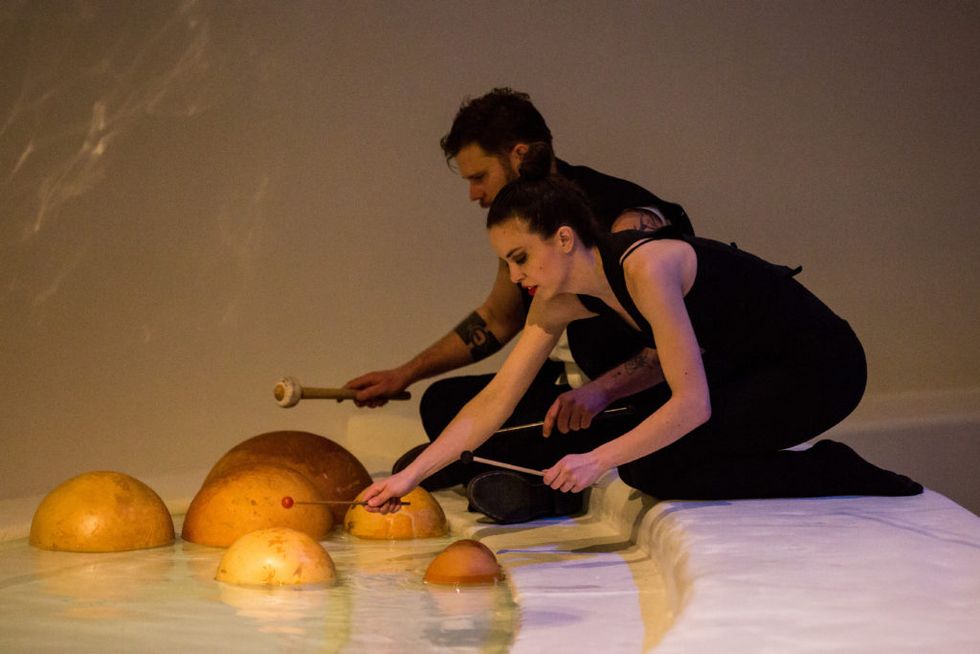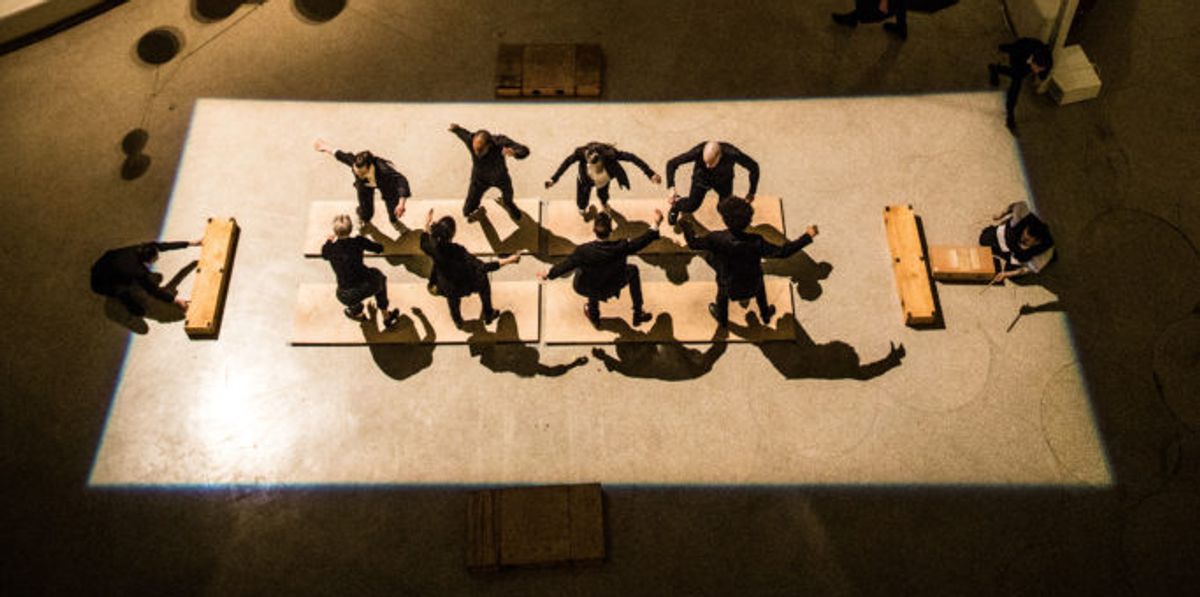Michelle Dorrance Took Over the Guggenheim Rotunda, And It Was Genius
Michelle Dorrance
isn’t a MacArthur-certified “Genius” for nothing. Last night at New York City’s Guggenheim Museum, she premiered the first ever Works & Process Rotunda Project, a brand new initiative announced last summer that commissions site-specific work specifically for the Guggenheim’s iconic Frank Lloyd Wright–designed Rotunda. (Next up: Daniil Simkin.)
Dorrance’s project, in collaboration with fellow hoofer Nicholas Van Young, has set the bar for future projects almost unfairly high. The 40 minute piece was funny yet breathtaking, endlessly entertaining but compositionally brilliant, and as interesting aurally as it was visually. It had all of the rhythmic complexity that we’ve come to expect from Dorrance’s work, but by placing the audience on the ramps (spiraling up seven stories) and the performers on the floor (okay, and occasionally on the ramps, too), the rhythms took on new dimensions. Basically, we loved it. Here are six reasons why.
It was impossible to label it as a single dance style.
I spied breakdance, contemporary release technique, hints of Latin ballroom and (of course) some fantastic soft- and hard-shoe tap. Aside from hoofers Dorrance and Van Young, break dancers Ephrat Asherie and Matthew West were the other featured couple. Mixing genres can be hit or miss, but in this case the the amalgam of styles was a definite hit.

Dorrance and Van Young making music.All images: Works & Process Rotunda Project: Michelle Dorrance with Nicholas Van Young, February 16, 2017, Solomon R. Guggenheim Museum Rotunda. Photos by: Matthew Murphy
The dancers were musicians, and the musicians dancers.
Dorrance spent as much time astride a drum as she did battling with Van Young on mobile platforms or using wooden sticks. A trio of dancers appeared periodically on the ramps to sing haunting melodies. The dancers who played instruments never felt secondary, because making dance and making music were valued equally—and often were the same action. It was surreal seeing familiar tap steps but hearing them sound completely different because of the acoustics of the space. The sensibility that anything can be a percussive instrument, including the ramps and walls of the Rotunda, pervaded the work, a strong reminder that both Dorrance and Van Young are STOMP veterans.
The audience made music, too.
In one well-received section, Van Young stood in the center of a platform on the floor and wordlessly coached the sections of the audience in different clapping rhythms. If you were in the room, you had to pay attention—otherwise you’d definitely miss your cue—and it made everyone watching acutely aware of just how difficult it was to coordinate the complex sounds we’d been hearing from the performers all night. (As Dorrance put it, “Acoustically, this thing is a whole new animal.”)
She took advantage of the “fifth wall” to add a new dimension.
There was as much attention paid to how the work would look from above as to how it sounded—the intricate pathways carved by the performers had an almost kaleidoscopic effect, so no matter how high up you were you had something fascinating to see. When Asherie used b-girl floorwork to cross the floor, she seemed to be floating in space; when a handful of the performers ended the piece lying flat on their backs and took their bows from there, it created an optical illusion of them standing on the walls. And their energy was infectious—even if you couldn’t see their faces from above, you could feel the focus, joy and determination radiating from every person on the floor.

Dorrance and Van Young.All images: Works & Process Rotunda Project: Michelle Dorrance with Nicholas Van Young, February 16, 2017, Solomon R. Guggenheim Museum Rotunda. Photos by: Matthew Murphy
She really responded to the space.
When we talked to Dorrance about the project in November, she had a few ideas of what she wanted to do with it, but was quick to point out, “We would be fools to walk in there and think we’re going to do something without the space telling us, ‘No, you’re not going to do this.’ ” Sure enough, the final structure was many, many steps removed from the initial ideas she had tossed around before beginning rehearsals, but the exploration she had set for herself—”non-traditional percussive movement, in a direction where we maximize what we can do in that space”—was evident throughout.
It

was just fun. I saw senior citizens, small children and everyone in between crowded onto the ramps, and not a single person wasn’t nodding along to the beat at some point or cheering as hard as they could by the end. You never knew what was going to happen next, but it almost inevitably evoked smiles, laughs or murmurs of approval. Who says great, serious choreography can’t be fun?All images: Works & Process Rotunda Project: Michelle Dorrance with Nicholas Van Young, February 16, 2017, Solomon R. Guggenheim Museum Rotunda. Photos by: Matthew Murphy
Best of all, if you weren’t one of the lucky few to make it to the one-night-only show, one of the performances was streamed via Facebook Live—you can watch it here.
All images: Works & Process Rotunda Project: Michelle Dorrance with Nicholas Van Young, February 16, 2017, Solomon R. Guggenheim Museum Rotunda. Photos by: Matthew Murphy




